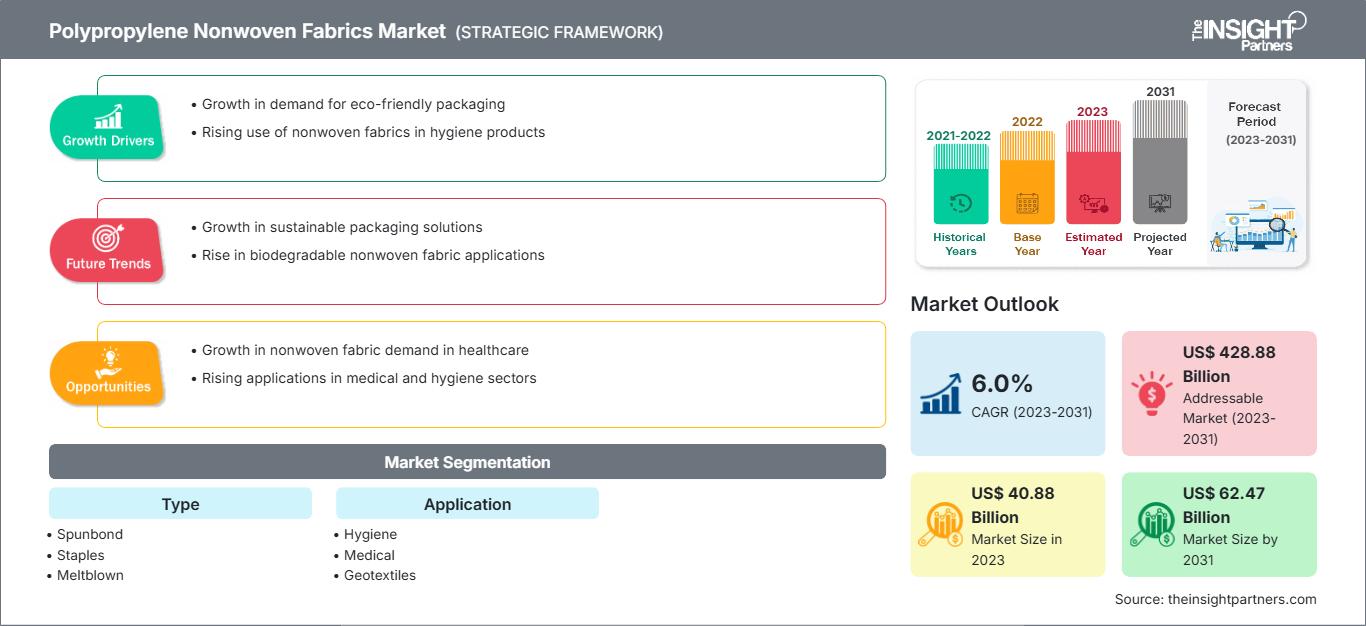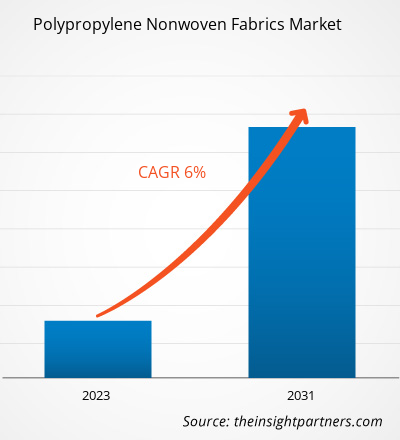Si prevede che il mercato dei tessuti non tessuti in polipropilene raggiungerà i 62,47 miliardi di dollari entro il 2031, rispetto ai 40,88 miliardi di dollari del 2023. Si prevede che il mercato registrerà un CAGR del 6,0% tra il 2023 e il 2031. La crescente domanda da parte di settori applicativi, tra cui agricoltura ed edilizia, rimarrà probabilmente una tendenza chiave del mercato dei tessuti non tessuti in polipropilene.
Analisi di mercato dei tessuti non tessuti in polipropilene
La crescente domanda nel settore dei geotessili ha guidato in modo significativo la crescita del mercato dei tessuti non tessuti in polipropilene. I geotessili sono fondamentali nei progetti di ingegneria civile e di costruzione, con funzioni quali il controllo dell'erosione, la stabilizzazione del suolo e il drenaggio. Le proprietà essenziali di questi tessuti, come resistenza, permeabilità e resistenza ai fattori ambientali, li rendono un materiale preferito per le applicazioni geotessili. Con il crescente numero di progetti di sviluppo infrastrutturale, cresce la necessità di materiali affidabili e durevoli per migliorare la longevità e la stabilità delle strutture. I tessuti non tessuti in polipropilene offrono inoltre un'efficiente separazione degli strati di terreno, offrono rinforzo in aree con terreno instabile e prevengono l'erosione. Questi tessuti sono anche leggeri, il che contribuisce a facilitare l'installazione e la movimentazione nelle applicazioni geotessili. Ciò contribuisce a ridurre i costi di manodopera e trasporto. Inoltre, questi tessuti mostrano un'eccellente resistenza alla degradazione chimica e biologica, garantendo prestazioni durature in diverse condizioni ambientali.
Panoramica del mercato dei tessuti non tessuti in polipropilene
I tessuti non tessuti in polipropilene resistono fortemente a liquidi e contaminanti, rendendoli ideali per applicazioni in tessuti medicali e prodotti igienici. Questi tessuti sono anche ampiamente utilizzati per la produzione di camici chirurgici, mascherine e teli nel settore medico. La resistenza del polipropilene garantisce la durata dei tessuti non tessuti. Ciò fornisce protezione agli operatori sanitari e ai pazienti durante le applicazioni mediche. Inoltre, la traspirabilità dei tessuti non tessuti in polipropilene è importante per garantire il comfort, consentendo il passaggio dell'umidità dell'aria mantenendo una barriera protettiva contro i microrganismi. Le caratteristiche uniche del tessuto non tessuto in polipropilene sono vantaggiose per vari prodotti igienici come pannolini e assorbenti. La morbidezza, la resistenza all'umidità e il comfort del tessuto non tessuto in polipropilene lo rendono la scelta perfetta per queste applicazioni. La versatilità del materiale consente la creazione di prodotti altamente assorbenti e confortevoli per un uso prolungato.
Personalizza questo rapporto in base alle tue esigenze
Potrai personalizzare gratuitamente qualsiasi rapporto, comprese parti di questo rapporto, o analisi a livello di paese, pacchetto dati Excel, oltre a usufruire di grandi offerte e sconti per start-up e università
Mercato dei tessuti non tessuti in polipropilene: Approfondimenti strategici

-
Ottieni le principali tendenze chiave del mercato di questo rapporto.Questo campione GRATUITO includerà l'analisi dei dati, che vanno dalle tendenze di mercato alle stime e alle previsioni.
Fattori e opportunità del mercato dei tessuti non tessuti in polipropilene
La crescente domanda per l'industria automobilistica sostiene la crescita del mercato dei tessuti non tessuti in polipropilene
La flessibilità di questi tessuti li rende compatibili con numerose applicazioni automobilistiche. I tessuti non tessuti in polipropilene sono ampiamente utilizzati in componenti come moquette, rivestimenti e materiali isolanti per gli interni dei veicoli. La modellabilità di questi tessuti consente di creare design complessi e caratteristiche interne personalizzate, offrendo alle case automobilistiche una soluzione flessibile ed economica. Inoltre, la crescente attenzione dell'industria automobilistica alla sostenibilità si allinea alle caratteristiche ecocompatibili dei tessuti non tessuti in polipropilene. Questi tessuti offrono anche alternative riciclabili ed efficienti dal punto di vista energetico rispetto ai materiali tradizionali. La crescente adozione di pratiche ecosostenibili ha stimolato la domanda di questi tessuti. Anche la crescente diffusione dei veicoli elettrici (EV) ha favorito la crescita del mercato. La crescente necessità di alleggerimento per migliorare l'efficienza energetica e di carburante ha inoltre rafforzato la domanda di questi tessuti grazie alle loro proprietà di leggerezza.
Crescente adozione nei settori dell'edilizia e dell'agricoltura
Le proprietà uniche dei tessuti non tessuti in polipropilene, che rispondono a esigenze specifiche nei settori dell'edilizia e dell'agricoltura, sono i principali motori di crescita del mercato. Questi tessuti sono ampiamente utilizzati nelle applicazioni geotessili nel settore edile. Sono ampiamente utilizzati nel controllo dell'erosione, nella stabilizzazione del suolo e nei sistemi di drenaggio. La loro capacità di fornire rinforzo, filtrazione e separazione in vari progetti di costruzione contribuisce alla crescente popolarità dei tessuti non tessuti in polipropilene. Questi tessuti contribuiscono a migliorare l'integrità strutturale di strade, dighe e altri progetti di ingegneria civile, rendendoli una componente essenziale nelle moderne pratiche di costruzione.
Inoltre, questi tessuti svolgono un ruolo significativo nella protezione e nella gestione delle colture in agricoltura. I tessuti non tessuti in polipropilene sono ampiamente utilizzati come coperture per le colture per proteggere le piante da parassiti, condizioni meteorologiche avverse e radiazioni UV. La natura porosa di questi tessuti consente all'aria, alla luce solare e all'umidità di raggiungere le piante e fornisce una barriera protettiva contro elementi esterni come i parassiti. Inoltre, la domanda di tessuti non tessuti in polipropilene è aumentata significativamente con la crescente popolarità di alternative sostenibili agli erbicidi chimici nelle applicazioni di controllo delle erbe infestanti.
Analisi della segmentazione del mercato dei tessuti non tessuti in polipropilene
I segmenti chiave che hanno contribuito all'analisi del mercato dei tessuti non tessuti in polipropilene sono il materiale e l'applicazione.
- In base alla tipologia, il mercato è segmentato in spunbond, punti metallici, meltblown e compositi. Il segmento spunbond ha detenuto una quota di mercato maggiore nel 2023.
- In termini di applicazione, il mercato è segmentato in igiene, medicale, geotessile, automobilistico, edilizia, agricoltura e altri. Il segmento dell'igiene ha detenuto la quota maggiore del mercato nel 2023.
Analisi della quota di mercato dei tessuti non tessuti in polipropilene per area geografica
L'ambito geografico del rapporto sul mercato dei tessuti non tessuti in polipropilene è suddiviso principalmente in cinque regioni: Nord America, Asia-Pacifico, Europa, Medio Oriente e Africa e America meridionale e centrale.
Con l'espansione dei settori, aumenta la domanda di questi tessuti in applicazioni che spaziano dai prodotti per l'igiene e dai tessuti medicali ai geotessili e ai componenti per autoveicoli. Il fiorente settore manifatturiero della regione e la crescita demografica accrescono ulteriormente la necessità di questi materiali versatili. La competitività in termini di costi è un altro fattore cruciale. La regione Asia-Pacifico è nota per le sue capacità produttive a basso costo, trainate da fattori quali minori costi di manodopera ed efficienti processi produttivi. Questo vantaggio in termini di costi consente ai produttori della regione di produrre tessuti non tessuti in polipropilene a prezzi competitivi, soddisfacendo la domanda sia del mercato nazionale che internazionale. Questi fattori stanno guidando la crescita del mercato dei tessuti non tessuti in polipropilene nell'area Asia-Pacifico.
Tessuti non tessuti in polipropilene
Approfondimenti regionali sul mercato dei tessuti non tessuti in polipropilene
Le tendenze regionali e i fattori che influenzano il mercato dei tessuti non tessuti in polipropilene durante il periodo di previsione sono stati ampiamente spiegati dagli analisti di The Insight Partners. Questa sezione illustra anche i segmenti e la geografia del mercato dei tessuti non tessuti in polipropilene in Nord America, Europa, Asia-Pacifico, Medio Oriente e Africa, America meridionale e centrale.
Ambito del rapporto di mercato sui tessuti non tessuti in polipropilene
| Attributo del rapporto | Dettagli |
|---|---|
| Dimensioni del mercato in 2023 | US$ 40.88 Billion |
| Dimensioni del mercato per 2031 | US$ 62.47 Billion |
| CAGR globale (2023 - 2031) | 6.0% |
| Dati storici | 2021-2022 |
| Periodo di previsione | 2023-2031 |
| Segmenti coperti |
By Tipo
|
| Regioni e paesi coperti |
Nord America
|
| Leader di mercato e profili aziendali chiave |
|
Densità degli attori del mercato dei tessuti non tessuti in polipropilene: comprendere il suo impatto sulle dinamiche aziendali
Il mercato dei tessuti non tessuti in polipropilene è in rapida crescita, trainato dalla crescente domanda degli utenti finali, dovuta a fattori quali l'evoluzione delle preferenze dei consumatori, i progressi tecnologici e una maggiore consapevolezza dei vantaggi del prodotto. Con l'aumento della domanda, le aziende stanno ampliando la propria offerta, innovando per soddisfare le esigenze dei consumatori e sfruttando le tendenze emergenti, alimentando ulteriormente la crescita del mercato.

- Ottieni il Mercato dei tessuti non tessuti in polipropilene Panoramica dei principali attori chiave
Notizie e sviluppi recenti sul mercato dei tessuti non tessuti in polipropilene
Il mercato dei tessuti non tessuti in polipropilene viene valutato raccogliendo dati qualitativi e quantitativi a seguito di ricerche primarie e secondarie, che includono importanti pubblicazioni aziendali, dati di associazioni e database. Di seguito è riportato un elenco degli sviluppi nel mercato dei tessuti non tessuti in polipropilene e delle relative strategie:
- Toray Industries, Inc., ha annunciato oggi di aver creato un tessuto non tessuto spunbond costantemente idrofilo (vedere la nota 1 del glossario) e delicato sulla pelle. Questo tessuto è adatto per pannolini usa e getta, mascherine, prodotti per l'igiene femminile e altre applicazioni sanitarie. L'azienda prevede di avviare la produzione su larga scala quando la tecnologia di produzione sarà consolidata. (Fonte: Toray Industries, Inc., Comunicato stampa, 2022)
Copertura e risultati del rapporto sul mercato dei tessuti non tessuti in polipropilene
Il rapporto "Dimensioni e previsioni del mercato dei tessuti non tessuti in polipropilene (2021-2031)" fornisce un'analisi dettagliata del mercato che copre le seguenti aree:
- Dimensioni e previsioni del mercato a livello globale, regionale e nazionale per tutti i segmenti di mercato chiave coperti dall'ambito
- Dinamiche di mercato come fattori trainanti, vincoli e opportunità chiave
- Principali tendenze future
- Analisi dettagliata delle cinque forze di Porter e SWOT
- Analisi del mercato globale e regionale che copre le principali tendenze di mercato, i principali attori, le normative e i recenti sviluppi del mercato
- Analisi del panorama industriale e della concorrenza che copre la concentrazione del mercato, l'analisi della mappa termica, gli attori principali e gli sviluppi recenti
- Profili aziendali dettagliati
- Analisi storica (2 anni), anno base, previsione (7 anni) con CAGR
- Analisi PEST e SWOT
- Valore/volume delle dimensioni del mercato - Globale, Regionale, Nazionale
- Industria e panorama competitivo
- Set di dati Excel
Report recenti
Testimonianze
Motivo dell'acquisto
- Processo decisionale informato
- Comprensione delle dinamiche di mercato
- Analisi competitiva
- Analisi dei clienti
- Previsioni di mercato
- Mitigazione del rischio
- Pianificazione strategica
- Giustificazione degli investimenti
- Identificazione dei mercati emergenti
- Miglioramento delle strategie di marketing
- Aumento dell'efficienza operativa
- Allineamento alle tendenze normative






















 Ottieni un campione gratuito per - Mercato dei tessuti non tessuti in polipropilene
Ottieni un campione gratuito per - Mercato dei tessuti non tessuti in polipropilene